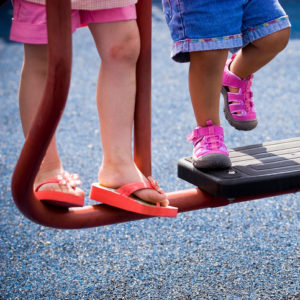
One of the best things about summer is the wardrobe change. No more need to pull on snowsuits, scarves, hats, gloves and boots. Oh, the joy of shorts and t-shirts, being ready for the outdoors at any moment!
Alzein Pediatrics has a word of warning: Don’t get too relaxed about footwear. We know flip flops are super easy, but they are also cause a super amount of trouble. Flips flops, or thongs, those rubber shoes with just a strap between the toes, are one of the most hazardous choices you can make for your child.
The most basic function of a shoe is to protect the foot from injury. Immediately, flip flops fail this test. Flip flops expose wearers to blunt trauma, punctures, cuts and scrapes. The toe straps can rub, causing blisters and open wounds. Because flip flops catch on the walking surface and bend back, your child is at a much higher risk for stubbed toes, torn toe nails and toe fractures. The foot is not held firmly in place in the flip flop so the foot moves constantly on the base, causing rubbing and blisters. All these wounds leave your child’s at great risk of contracting warts, HPV, staphylococcus and fungal infections of the feet and of the toenails. Even worse, tripping in a flip flop can cause serious bone breaks, sprains, and inflamed, ruptured or torn ligaments. Wearing a wet or damp flip flop is especially dangerous to stability and the safety of the foot.
And that’s just the tip of the iceberg. Wearing flip flops as a child can cause a lifetime of pain.
“Walking in a flip flop changes your child’s way of walking,” says Dr. Alzein. “This altered gait, caused by a shorter stride and the unnatural toe curling and gripping to hold the flip flop in place, abnormally stretches the arch and tendons, doesn’t develop the proper muscles needed for a healthy stride, strains muscles and bones, changes your child’s posture, and will cause life long problems in the feet, ankles, knees, hips and back.”
Flip flops will cause flat feet from lack of arch support, toe deformities, plantar fasciitis and bone pain. Flip flop wearers are more like to experience stress fractures from the lack of shock absorption and lack cushioning on the ball and heel of the foot.
A better choice? “Bump-toe” sandals, available in a variety of prices at local stores and online. These shoes, the pink ones in the middle in the photo above, are easy to put on, dry quickly if they become wet and give your child’s foot the support needed.
Dr. Alzein says, “Look for shoes that fit your child’s foot, both width and length. Avoid buying shoes with room to grow, as these are tripping hazards, along with causing blisters and sores, which again leads to an altered gait. Shoes should have both sturdy heel coverage and toe coverage. The shoe should not be able to twist or bend. Straps should keep the foot firmly in place in the shoe.
Avoid passing shoes down to other children, as the unique wear pattern from the first owner will disrupt the next child’s natural gait and foot shape.
“Never allow your child to wear flip flops while biking, running or using a scooter or skateboard,” says Dr. Alzein.
Is there a place for flip flops? “Yes,” says Dr. Alzein. “Flip flops are great for the beach and for the pool. Wear them there, and make a healthier choice for everyday shoes.”


